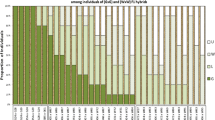Abstract
Tubers of a number of garden dahlia cultivars were irradiated with various dosages of X-rays. The optimal dose ranges from 2 to 3 krad, considering the production of rooted cuttings, the speed of rooting, the subsequent development of the young plants as well as mutation frequency.
A great number of mutations for flower colour and shape were observed in the irradiated varieties "Salmon Rays", "Arthur Godfrey" and "Eldorado". Four mutants of "Salmon Rays" have been awarded, named, registered as new varieties and put on the market (see colour pictures and description in the text).
The very quick results (the tubers were irradiated only three years ago, in November 1963) are largely due to the propagation method used in Dahlia. This method, taking a series of cuttings from the crown of the irradiated tubers, often results in mutated tissue taking part in the formation of new tubers, thus enabling the mutated character to be transmitted to the next vegetative generation. Alternatively one may consider the rooting of softwood cuttings after the observation of an interesting mutation and their propagation after the overwintering under suitable greenhouse conditions (temperature, long day). However, the usually high percentage of so-called "blind" tubers formed in the latter case, may give insuperable difficulties.
The possibility of mutation induction in other cultivars of the octoploid garden dahlia strongly depends upon their genetic constitution. The complicated genetics and the great number of flower colour genes involved, make it difficult to predict which varieties may or may not give positive results.
Similar content being viewed by others
References
Broertjes, C., Mutatieveredeling van siergewassen. Meded. Dir. Tuinb. 29(9): 434–438, 1966.
Broertjes, C., Mutation breeding of Chrysanthemums. Eu[hytica 15(2): 156–162, 1966.
Crane, M. B. and W. J. C. Lawrence, The genetics of garden plants. MacMillan and Co., London, 1956.
Dommergues, P., e.a., L'induction de mutations chez les rosiers. Induced mutations and their utilization, Gatersleben 1966 (in press).
Lawrence, W. J. C., The genetics and cytology of Dahlia variabilis. J. Genet. 24: 257–307, 1931.
Lawrence, W. J. C., The origin and genetics of the garden Dahlia. Proc. of Linn. Soc. London, 1933.
Lawrence, W. J. C., The origin of the garden Dahlia, 1942.
Mehlquist, G. A. L. and Y. Sagawa, The effect of gamma radiation on carnation. Proc. X Int. Bot. Congress, 2: 258, 1959.
Moës, A. Mutations induites chez le glaïeul (Gladiolus). Bull. des Recherches Agron. de Gembloux. N.S. 1, no. 1, 1966.
Mol van Oud Loosdrecht W. E. de, X-raying of hyacinths and tulips from the begining, before thirty years (1922) till to-day (1952). Jap. J. Breed. 3(1): 1–8, 1953.
Streitberg, H., Schaffung von Sprossvarianten bei Azaleen durch Behandlung mit Röntgnstrahlen. Zeitschr. f. Pfl. z. 56(1): 70–87, 1966.
Streitberg, H., Rosenzüchtung mit Hilfe der Röntgenbestrahlung. Arch. Gartenbau 14: 81–88, 1966.
Additional information
Association Euratom-ITAL, Wageningen, The Netherlands.
Fa. Ballego en Zonen, Leiden, The Netherlands.
Rights and permissions
About this article
Cite this article
Broertjes, C., Ballego, J.M. Mutation breeding of Dahlia variabilis. Euphytica 16, 171–176 (1967). https://doi.org/10.1007/BF00043451
Received:
Issue Date:
DOI: https://doi.org/10.1007/BF00043451




